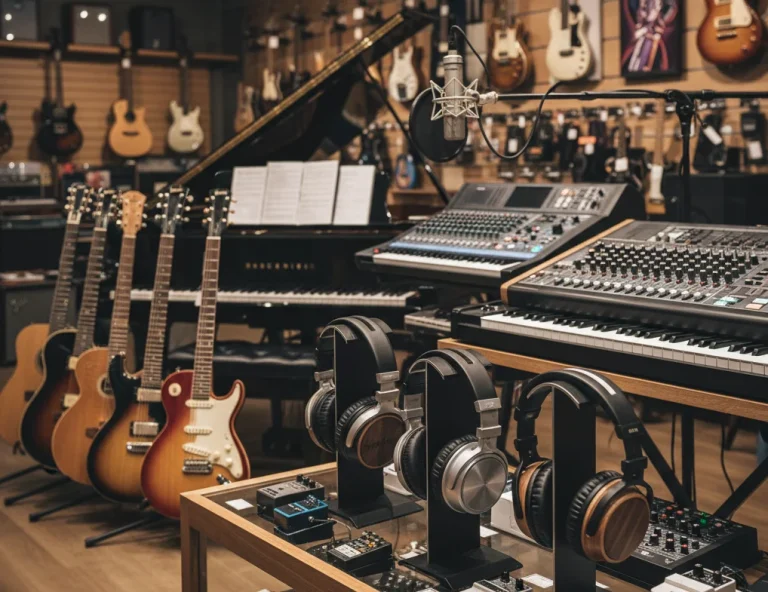All Topics
- Alchemizing Music Concepts for Students
- Artist Spotlight
- artium gift card
- Artium Maestros
- Artium News
- buying guide
- Carnatic Music
- Devotional Music
- Editorials by Ananth Vaidyanathan
- Film Music
- Guitar
- Hindustani Classical Music
- Indian Classical Music
- Indian Folk Music
- Insights
- Instruments
- Karaoke Singing
- Keyboard
- Kids Music
- maestros
- Music Education
- Music for Kids
- Music Industry
- Music Instruments
- Music Legends
- Music Theory
- Music Therapy
- Piano
- piano guide
- Success Stories
- Tamil Film Music
- Telugu Film Music
- Time Theory
- Tools
- Uncategorized
- Vocal Singing
- Vocals
- western classical music
- western music
- Western vocal music
The Complete Guide to Learning Guitar for All Skill Levels
The Complete Guide to Learning Guitar for All Skill Levels

Table of Contents
Let us embark on a grand journey with one of the most iconic musical instruments ever. It is such an instrument that is practically used in almost every song. It is an instrument with many styles and types to follow and learn.
Of course, we are talking about the guitar. As stated, it is one of the most iconic instruments ever and a great starting instrument for many budding artists. Learning the guitar is not just about playing notes; it’s about expressing yourself, connecting with music, and unlocking a world of creativity. If you are an established and experienced player or a new, budding musician, this blog is the right place for you.
With this complete guide to learning guitar, we will cover all the main aspects required to learn the guitar so that you can fully embrace your musical side and take steps to grow in that direction. We will cover each step of the process from beginner to intermediate and finally advanced to ensure that you can pick up and learn no matter your ability with the guitar. Online guitar courses can also be extremely helpful for fully taking in the learnings.
But before that…
If you’re really excited to start your journey in music, start with a free trial lesson today!
So, take up your guitar and let us embark on this beautiful journey with this guitar learning guide for all skill levels.
Understanding the Basics of Guitar
As you participate in online guitar classes, understanding the basics is necessary for success. To start, let us look at the parts of a guitar. Here is a quick breakdown:
- Body: The central part of the guitar. For acoustic guitars, it amplifies the sound; for electric, it houses electronics.
- Neck: The long wooden section where the frets and fretboard are located.
- Frets: Metal strips on the neck that divide it into notes.
- Strings: Normally, six guitarists pluck or strum these to produce sound. Each string represents a different note.
- Headstock: The top part of the guitar, where the tuning pegs are located.
- Tuning Pegs: These are used to adjust the tension of the strings and help keep the guitar in tune.
Your next aspect to understand is the types of guitars available. Within this vast realm of guitars, there are only two types of guitars:
- Acoustic Guitars: If you want to begin your guitar learning journey, an acoustic guitar is a great instrument to do it with. Known for its simplicity, it is best for beginners and all, alike.
- Electric Guitars: This guitar requires an amplifier to produce sound. It’s perfect for rock, blues, and jazz, offering various tones and effects.
After the parts and types of guitars, one last fundamental aspect to be understood are some of the basic concepts followed while you learn guitar:
- Tuning: Each string on the guitar is meant to play a specific note. To ensure you play it right, tuning the guitar is necessary. Proper tuning ensures your guitar sounds great.
- String Names: Remembering string names is simple with mnemonics like “Eddie Ate Dynamite, Good Bye Eddie.”
- Impact on Playing: Correct tuning and understanding of string names help you play chords, scales, and songs effectively.
Choosing the Right Guitar for Your Skill Level
Before you figure out how to learn guitar, whether through online guitar classes or something else, you must first choose the right guitar to play with. Selecting the best guitar depends on your experience, goals, and preferences. So, to help you out, here are a few practical tips that you could follow:
- For Beginners:
- Kids learning guitar or beginners learning guitar should consider starting with an acoustic guitar. Its simplicity and natural sound make it an excellent choice for foundational skills.
- Nylon-string acoustic guitars are softer on the fingers and ideal for classical or fingerstyle music.
- For Intermediate and Advanced Players:
- If you’re finally comfortable diving into a genre of your choice, an electric guitar can be ideal.
- Explore guitars with additional features like cutaways for easier access to higher frets or specialized pickups for different tones.
As always, with any major purchase, there are a few factors for you to consider. The size or body type of the guitar, the strings used and your style preferences are all things to be kept in mind as you look for your ideal guitar. The body type matters, as both large and small produce different kinds of sounds, with large producing louder and deeper sounds, whereas small produces more comfortable and tone-focused sounds.
Your last factor is always the budget you have. Set a realistic budget based on your commitment level. Beginners can find quality entry-level guitars for a reasonable price. Try out guitars in a store, or look for trusted online reviews and recommendations.
Essential Guitar Accessories You’ll Need
Before you commence your online guitar lessons, a few accessories are essential for playing the guitar. Here is a quick breakdown of them:
- Picks: These small tools help you strum or pick strings with precision. They come in different thicknesses, so experiment to find a comfortable one.
- Capo: A capo clamps onto the guitar’s neck, allowing you to play in different keys without changing your finger positions.
- Guitar Straps: If you wish to play the guitar standing in a stable position, a strap is necessary to hang the guitar around your body.
- Tuners: To ensure you play the music you want correctly, using a tuner to keep your guitar tuned is quite helpful. Clip-on electronic tuners are easy to use and highly accurate.
- Cases: As the name suggests, you can keep your guitar safely within a strong and efficient case. A soft gig bag is lightweight and great for short trips, while a hard case offers maximum protection.
Setting Up Your Guitar for Optimal Playability
Before you start playing, you need to ensure that your guitar is ready to be played. You need to ensure it is set up correctly before you start playing. Here’s how to prepare your guitar:
- Tuning your guitar is the first and most crucial step. Use an electronic tuner or a tuning app for accuracy. Tune each string to its designated note. Check the tuning regularly, as the strings can come loose over time.
- Make sure your strings are in good condition. Over time and usage, they can become covered with grime and oil, making it harder to play correctly. Replace old or rusted strings to maintain sound quality.
- One more thing you must also ensure is that the bridge is secure and correctly aligned. As you learn guitar, you will understand that the bridge supports the strings and influences the guitar’s sound.
- Finally, conduct generalised maintenance on your guitar regularly. Keep an eye on the fretboard and clean it every day. Tighten any loose tuning pegs or hardware.
If you feel unsure about anything, reach out to a professional. It could be an experienced player or a teacher; they can help guide you.
Beginner’s Guide to Guitar Playing
Now that your guitar is ready to be played, here are the steps for you to follow and ensure you have a smooth playing experience:
- First, you should understand how to hold your guitar. Take a seat with your back straightened. Rest the guitar on your dominant leg and ensure that the guitar is slightly tilted upwards for easier and better reach. Use your fretting hand to lightly hold the neck while your strumming hand hovers over the strings.
- From there, you should follow some basic strumming techniques. Use a pick or your hand and proceed to strum the strings. Start with a downward stroke across all the strings. You can then practice alternating downstrokes and upstrokes to build a rhythm.
- Once you start feeling comfortable with strumming, start learning some basic chords. Try learning the open position of the C Major Scale first. Use your index, middle, and ring fingers to navigate the frets. Focus on accuracy and smooth transitions between notes.
Intermediate Techniques to Expand Your Skills
As you slowly grow your abilities and skills with the guitar, your understanding can be considered intermediate. This speaks to the sheer speed and knowledge you’ve mastered when you focus on your online guitar lessons. Now, as an intermediate, here are a few Intermediate Guitar Techniques for you to master.
- Bar Chords:
- Bar chords are essential for expanding your chord vocabulary and playing in various keys without relying on a capo.
- Use your index finger to press down all six strings on a fret, forming a “bar.” Shape the remaining fingers to form major, minor, or seventh chords.
- Fingerpicking:
- Fingerpicking adds texture and complexity to your playing. Start with simple patterns and gradually increase speed and intricacy.
- The thumb plucks the bass notes (6th, 5th, or 4th string), while the index, middle, and ring fingers pluck the 3rd, 2nd, and 1st strings.
- Scale Patterns:
- Scales form the foundation of solos, improvisation, and understanding music theory. Focus on the major and minor scales, along with the pentatonic scales.
- Begin with the C major scale (C-D-E-F-G-A-B-C) on the 8th fret of the 6th string.
- Chord Progressions:
- Chord progressions form the backbone of countless songs. Explore variations in rhythm and dynamics to enhance your expression.
- Start with common progressions like I-IV-V-I (C-F-G-C) or ii-V-I (Dm-G-C).
- Rhythmic Exercises:
- Rhythm is crucial for both solo and group playing. Develop your timing and groove.
- Practice downstrokes, upstrokes, and syncopated patterns on progressions like G-D-Em-C.
Advanced Techniques for Experienced Guitarists
Once you feel like you’ve mastered these techniques, your ability has finally reached a level that can only be considered advanced. This is where you can learn and fully master some of the more complicated techniques. However, these will ensure that you can play the best music possible. So, to support you, here are a few techniques that you can learn:
- Advanced Improvisation:
- Improvisation allows for personal expression and mastery over the fretboard. Focus on using modes (e.g., Dorian, Phrygian, Lydian) to add variety to your solos.
- Sweep Picking:
- Sweep-picking is a highly efficient technique for playing arpeggios at high speeds. Use a single fluid motion to pick consecutive strings, minimizing hand movement.
- Tapping:
- Tapping expands your reach on the fretboard, creating intricate melodies and harmonies. Use your picking hand to tap notes beyond your fretting hand’s range.
Common Mistakes to Avoid While Learning Guitar
It is human nature to make mistakes and falter at points. However, don’t worry. With your learning and consistent practice, you will constantly improve your abilities. Well, here are a few common mistakes that you can make sure to avoid as you learn:
- Skipping your practice is the first one to avoid at all costs. Inconsistent practice slows progress and hinders muscle memory. Set a regular practice schedule and stick to it, even if for just 15-20 minutes daily.
- Poor technique and improper hand position can lead to discomfort or even injury. Maintain a relaxed grip on the neck and ensure proper thumb placement behind the fretboard.
- Neglecting theory limits your ability to understand and create music. Dedicate time to learning scales, chords, and progressions. Apply theory concepts by analyzing your favouritefavorite songs and improvising with them.
Tips to Stay Motivated During Your Guitar Journey
No one said that this adventure would be an easy ride. There are times when you may wish to stop. But by doing that, you will be giving up on that incredible potential within yourself to grow and prosper with your musical abilities. As you go through online guitar classes, the teachers will take the necessary steps to ensure you stay motivated. Well, here are some of our tips as well:
- Set achievable goals. Goals give you direction and a sense of accomplishment. Break your objectives into manageable steps, such as mastering a specific technique or learning a new song. Celebrate milestones, like nailing a difficult solo or completing a composition.
- Connecting with other musicians can inspire and motivate you. Join a local band, participate in jam sessions, or become part of an online guitar forum. Sharing your progress and learning from others creates a supportive environment.
- Revisiting music that you love keeps the learning process enjoyable. Select tracks that challenge you while incorporating techniques you’re working on.
- Finally, enjoy the process. Remember that learning guitar is a journey, not just a destination.
Exploring Guitar Lessons and Online Resources
To ensure you fully gain the required knowledge, you have a better chance of joining a class or taking the help of a tutor. With online guitar lessons, you can take the journey from the ease of your home. Consider the program we offer at Artium Academy. We take pride in offering a performance-driven curriculum carefully designed by incredible maestros of the musical world. Whether you’re a budding musician or a seasoned player, our curriculum ensures you can fully explore and embrace your musical side.
Our approach ensures you receive attention and perfect instructions to help enhance your skills and musical proficiency. Keep an eye on your progress and achievements, and fully embrace your musical prowess. We offer exclusive personalised 1:1 live vocals and instrument classes conducted by music teachers who are established in their fields and verified.
Conclusion
Mastering the guitar can take a long time. However, don’t worry about your skill level; learning the guitar is rewarding. To master the guitar, consistent practice is needed. Keeping a schedule is your best course of action. Everyone learns at a different pace – as long as you properly absorb the knowledge, you are well on your way to becoming a good artist.
As you practice, take the time to explore different styles to find one that you resonate with. It can give you a sense of achievement when you master the style that best suits you and your tastes in music.
As you go down this beautiful adventure of music, understand that you aren’t alone. Our teachers at Artium Academy are ready to help you along the way and ensure your abilities can come to fruition.
Learn more about guitar, no matter your skill level, and book a free trial with us now!
FAQs on Guitar Learning
The time required to learn guitar depends on your practice routine and dedication. Beginners can start playing simple chords and songs within a few weeks, while mastering advanced techniques may take years.
For beginners, an acoustic guitar is often recommended due to its simplicity and affordability. However, if you prefer rock, blues, or jazz, an electric guitar may be a better choice.
Yes! Online guitar lessons are a great way to learn at your own pace. Many platforms offer structured lessons for all skill levels, along with video tutorials and interactive exercises.
No, but understanding basic music theory (like scales, chords, and rhythm) can help improve your playing and allow you to create your own music.
Practicing at least 20-30 minutes daily is recommended for consistent improvement. Longer and more focused practice sessions can help you progress faster.






